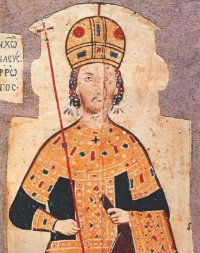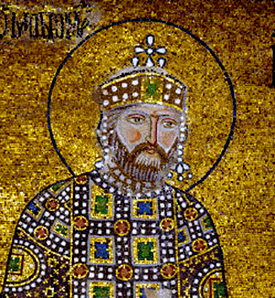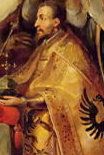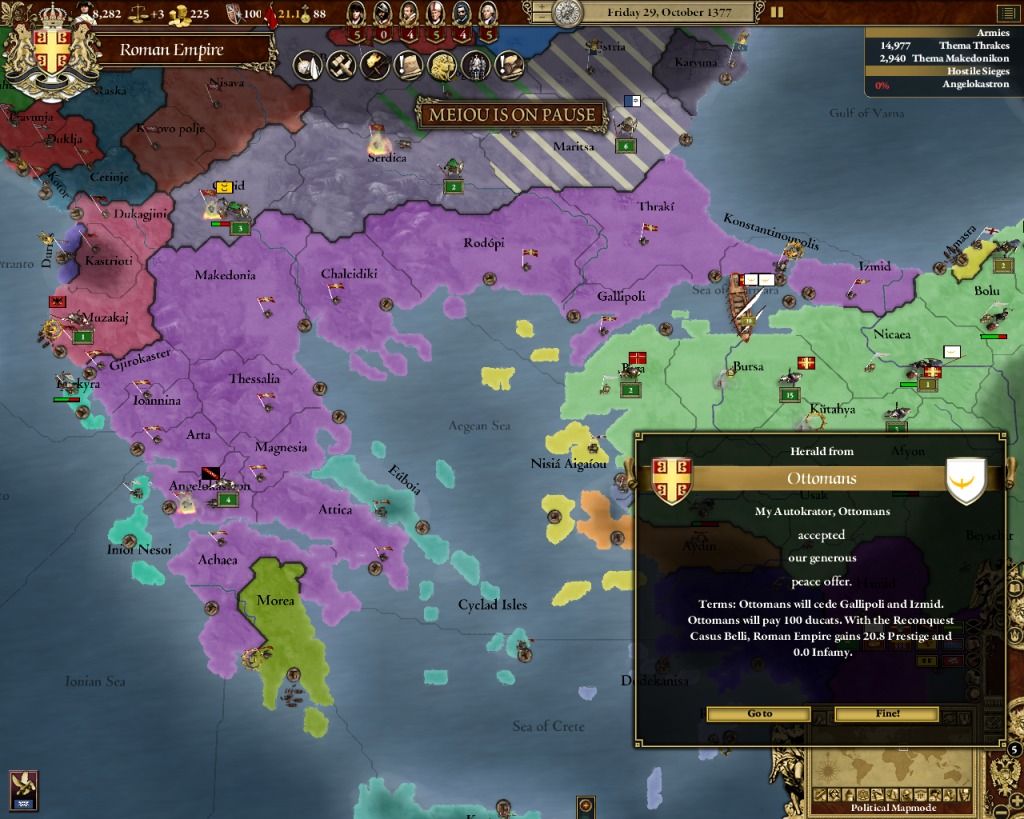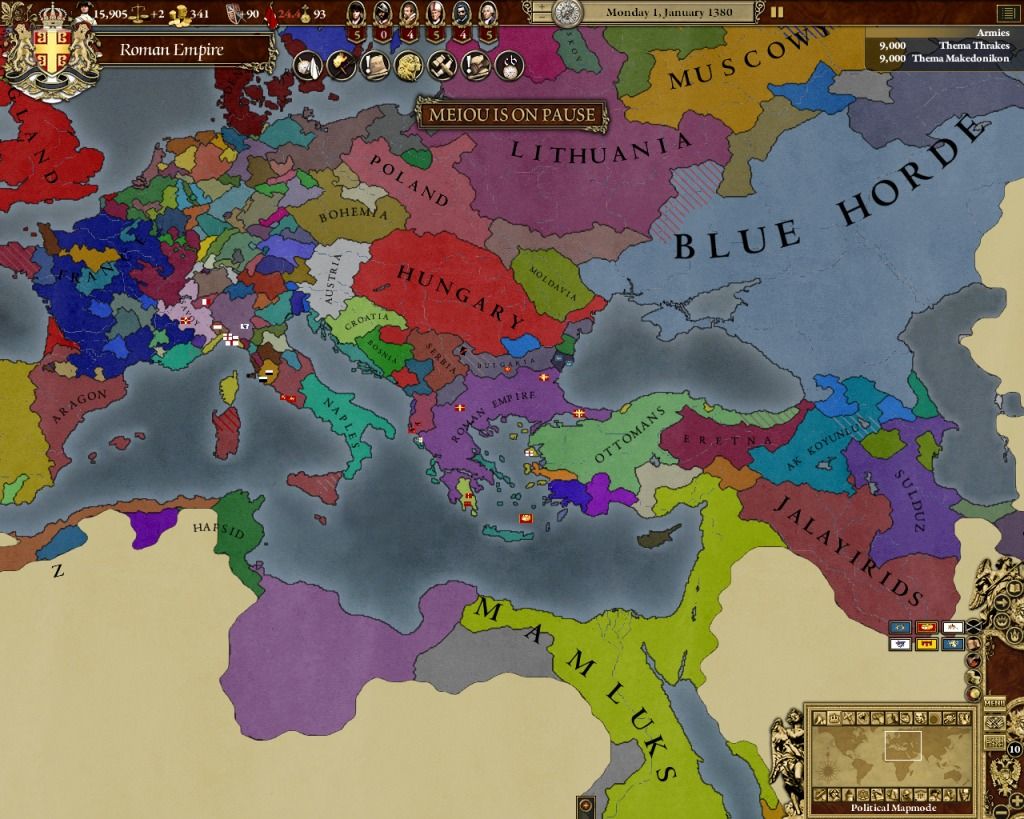Sorry, I couldn't wait - I've been working at this all day, and the mass praise has compelled me to post it early for you wonderful readers. I do spoil you, don't I, three days, three posts?
Early Life and Reign 1368-1380
The story of Manuel II's early life is largely the story of his father, born in 1354 after the death of his elder brother and heir apparent, also named Manuel. While his father was mostly campaigning in the field, Manuel spent a great deal of time in the libraries of Constantinople under the Italian scholar De Monteverdi, learning the history of the Empire that would one day be his, and studying the works of Latin authors, mostly the memoirs and diaries of Florentine or Tuscan rulers and statesmen, as well as practising combat with members of the Varangian Guard.
At the time of his father's stroke in 1368, Manuel was only fourteen years of age, but on the advice of his mother, he placed the regency of the city in the hands of De Monteverdi, much to the displeasure of the rest of the court, while he left to command the armies in the field. With the assistance of the retainers his father had collected, he concluded the wars his father fought, underwent the coronation aged seventeen, and became the formal Emperor of the Romans on the 1st September, 1371.
It is a testament to the skills of his father that neither he no De Monteverdi, who stayed on in Constantinople as an advisor, adjusted any domestic policies that John V had placed, retaining the same army, who returned home to their farms to await a recall by the
Stratikoi Serifi. After the wars of the last decade, De Monteverdi advised his student to avoid conflict for as long as possible, and instead to prepare for future wars by whatever means he deemed necessary. Imperial funds went into the construction of small arsenals in every provincial capital, so that the
Stratikoi Serifi could more effectively arm the men they conscripted for the Emperor. After 1372, sources indicate that whenever the regional armies gathered for inspection, every year two weeks before Michaelmas when not mobilised, each
Serifi presented roughly a thousand men from the province, with a few notable exceptions. Makedonia and Chalkidike both presented five thousand men, and the Constantinople
Serifoi presented a full ten thousand men.
Mehmet Katsouranis'
Chronicle describes the Constantinople levy, in superb detail:
“The first part of the army was 1000 men mounted on horseback, armed in the manner of the Turks with bow and arrows, firing from the saddle all at once before riding away again. The second part of the army, commanded by the Stratikoi Strategos, was clad in chain armour, with metal shields and Genose swords. Finally, the remainder of the army was formed of 5000 psiloi, some armed with bows and others with small spears for throwing, as well as knives taken from their homes. Standard bearers stood in between the blocks of men, waving the Imperial pennant from great poles made of iron.”
While this description of the Constantinople levy is probably overestimating the numbers of the men on parade, it is a useful measure of the equipment of the men, since at least half of them were either mounted or fought as heavy infantry, which is a superb indicator of the wealth in the Empire at this time – much of the loot from the Balkan Wars ended up in Constantinople, and if we take the figure of 80,000 people present in the city provided by Katsouranis'
Chronicle, roughly a tenth of the population of the City answered the call of the
Stratikoi Serifi, which is congruent with the populations of the other large cities, and a further half of this was either rich enough or had inherited enough equipment to provide a force with a quality higher than that of the Empire's neighbours. Nontheless, Katsouranis also indicates that the Turkish standing army, split between watching the shifting Eretnid border and guarding against Roman or Genoese invasion, stood at some sixty thousand foot and a further fifteen thousand horse – more than triple the forces available to Manuel II in 1372, who still lacked the military strength to truly dictate his own foreign policy.
In an attempt to increase the size of the grounds he could recruit from, in the winter of 1373, Manuel II marched a small force into Achaea, and the Prince (whose name does not appear in records) was forced to surrender his lands, and retired on a modest pension somewhere in the Morea, according to Manuel's orders. The largely Greek orthodox population of the Principality preferred their new master to the old Catholic one, and the implementation of the Roman administration occurred largely without incident. Apart from this single military enterprise, Manuel II's early foreign policy appears to have been one of appeasement; through monetary donations (a first for over four hundred years!) and agreements with the Genoese, Anconan and Savoyard polities, he created a network of allies in Italy, encouraged immigration and opened Galata to
'Friends of the Empire among the xenos' (Chronicle), which lead to a diversification of the City, with many Italian scholars visiting for months at a time, and bringing copies of the old Greek and Latin texts in Constantinople back to Italy, despite warnings from the Vatican (now ruled over by the Anconans, having conquered Rome in 1369), making Genoa, Savoy and Rome key cities of learning in Europe.
While the success of Manuel's foreign policy was clear, gaining the support of western allies that his father had never been able to achieve, there were also failings. The Venetians, angered by the extension of
asylia to some of their neighbouring commercial competitors, ended their alliance with the Empire, removing access to a fleet nearly two hundred ships strong that Manuel II badly needed – while the Genoese could project the power of their condottieri militias by way of their colonies at Amisos and other sites on the anatolian Black Sea coast, they did not have the long traditional of naval supremacy that the Venetians enjoyed, and the Romans, who had long since abandoned the sea to their former Italian foes, lacked the quality and experience necessary to compete at sea. Nevertheless, Manuel II continued to periodically send gifts of jewellery and silverware to the Doge of Venice, in the hopes of cultivating a positive relationship, which at least prevented the Venetians from launching any aggressive actions in the Aegean.
However, one key failure of Manuel II's foreign policy could not be ignored; he failed to create an amicable relationship with the Ottoman sultan Mehmed I Osmanli, who continued to allow Turkopole raiders into Thrace where they damaged villages and farmlands before the
Stratikoi Serifi could raise a response. It is important to note that there is no indication that the sultan actually encouraged this, only that he refused to dedicate any effort to end the incursions into his neighbour's territory. While this was probably because he preferred to man the forts at Gallipoli and on the border with the other Turk states, it would prove to be a costly mistake for the Ottomans.
In late 1373, a Turkopole raiding party reached Herakleia and forced open the gates, killed the guard and sacked the city, leaving about a thousand dead after three days of devastation. The
Stratikoi Serifi eventually came to the rescue of the city, having raised the troops around the city's farmlands, forcing the Turkopoles to return to the Gallopoli peninsula. In revenge, the commander of the forces commandeered several fishing vessels and their crews in the name of the
Stratikoi Serifi and sailed across the Bosphoros and raided coastal settlements between Nikomedia and Kyzikos, attacked several points along the Gallipoli peninsula, before returning to the suburbs of Herakleia.
Events quickly spiralled out of control, with both sides beginning to escalate from burning down towns to outright piracy. Eventually, Dionysos of Philadelphia, a cousin of Manuel's by marriage, one of the
Stratikoi Serifi, was killed by a raiding band of Gazmouli, an offence which Manuel could not tolerate. De Monteverdi died in the January of 1374, and the court at Constantinople is recorded as being in favour of military action. Manuel II, in a slight show of restraint, sent an envoy to Bursa with an ultimatum demanding
“...all Turks return to Asia, the [return of] Gallipoli, and indemnities of ten thousand pounds of silver...for if [we] enter the realm of the Turks, I shall raze every city, kill every man, rape every woman and baptise every child.”
Apparently, Mehmet's response to this was 'If you enter the realm of the Turks, you will never leave.” This may be an anachronism, based on the Spartan's response to Alexander the Great, but we do know that Mehmet's response caused Manuel to begin a full naval blockade of the Sea of Marmara, during which all ships were directed to the Golden Horn, with the exception of Manuel's Italian allies, who were allowed free passage. Incensed by this, Mehmet ordered an invasion of the Empire.
Most sources agree that no actual naval engagement took place; a few fishing vessels were seized by marines, but the Ottomans had no navy as such, and the garrison at Gallipoli were soon placed under siege by the Roman-Morean forces, while an army under Manuel II crossed the Marmara into Izmid (Optimaton), and despite initial failures secured a huge victory over Mehmet's army, defeating roughly 16,000 men and securing the area around Nikomedia. Over two years, with high casualties, one by one settlements were levelled by Manuel's army, which forced Mehmet to make a move – the Genoese were rampaging along the Black Sea coast, and with the Romans close to his capital Mehmet was compelled to provoke a pitched battle.
Early in June, Mehmet's army began to harass the Roman's left flank, forcing them away from Nicaea and Bursa, south towards Mentese, where the volatile border in the mountains would at least distract his enemy long enough to move reinforcements into the field. Throughout the summer, Mehmet's strategy worked; Manuel was unable to move south past the mountains, since the Mentese soldiers in the mountains would have destroyed his army piece by piece, and to the north lay the army of Mehmet, and while the superb condition of Manuel's army meant that in a pitched battle at this point, he might have won, he had no route for retreat, and remembering the fate of Romanos at Manizkert,decided instead to proceed east, hoping to circle around Mehmet and attack from Nicaea.
It was actually a set of events outside of Manuel's control that caused the Battle of Ayfon; in order to sustain themselves, Manuel's soldiers looted many Turkish towns, and while Mehmet could ignore their presence in his country until attrition gave him a chance to move, in their wake the Romans left volatile regions in which lesser beyliks and sultanates could move in and take advantage of their enemies' weakness.
Ebersbacher's Victory at Ayfon, 1854, depicting the last battle of the war.
Mehmet was forced to pursue the enemy and pacify the region, leading him back into the mountains. Upon hearing this, Manuel turned back, and forced Mehmet to engage him, but historians at the time disagree on his objective: Katsouranis suggests that Manuel wanted to score a decisive victory, to end any chance of Turkish victory, while Alexandros Kantakouzenos suggests that he wanted to capture the Sultan and avenge the defeat of Manzikert. Whatever his aims, the battle is unique in that it was one of the most finely recorded battles in late medieval history.
At the start of the engagement, Mehmet's army had deployed in a ring around their camp at the base of the mountains, mostly unmounted. One-quarter of the army's strength was deployed in the mountains, armed with longbows. Half the men were armed and armoured as spearmen, with chain armour, with a final quarter armed with captured Genoese arms and armour, as an anchor in the centre of the semicircle with backed onto the mountains. Manuel's army was much the same as in the description of the Constantinople levy by Katsouranis, confirmed by Kantakouzenos, who also tells us the disposition of Manuel's army, and the course of the battle in great detail:
“The Emperor stood at the centre of his army, with his oikoi (personal retainers) and the kataphraktoi, who had left their horses at the camp, for they could not ride on horseback in these high mountains. To the right and left, the common troops formed a long line, eight men deep, with each man armed with a sword, wooden shield and a long spear, which the rear ranks would use to fight over the shoulders of their friends in the front, who drew their swords. On each wing, the poorest of those called to service wore little armour, and threw javelins made from wood. Some used slings to throw the stones that were common there, while others had only what weapons they were endowed by God; their hands, with which they threw stones, or grappled with their foe.
In the late morning, Emperor Manuel ordered his men to march forwards, to match the pattern of the Turks, so that the men formed a great line encircling the Turkish camp. Their archers exchanged missiles with our psiloi, and for the better part of an hour they fought in this manner, until the Turks grew impatient, and the soldiers at the flanks charged our psiloi, who fled in great haste. The Turks, seeing this retreat, thought that they had won the day, and they continued their pursuit, so that the flanks of the Turkish army had outreached their friends, and ignored the orders of their leaders to return to the formation. One of the Emperor's lieutenants commanding the commoners, seeing an opportunity, rushed his men to surround the Turks on the right, so that they were forced against the mountainside and, unable to retreat, died to a man. Those on the left quickly returned to their leaders, seeing the danger they were in, and retreated back to their formation, but Mehmet was unable to close the hole in his line, and as such ordered his archers down from the mountains to guard the gap.
It was now afternoon, and as the Emperor reformed his men, he was pleased with the progress made. Ordering his psiloi to repeat their previous manoeuvre, throwing missiles at the Turks, but to no avail; they remained in place, and so he formed them into a single great group and threw them at the Turks, drawing some away from the centre of the line, where a gap opened. At once, Emperor Manuel ordered that his personal guard charge into the gap, and he himself did so, plunging a great wedge in the hole and widening it, surrounding the Turks and beginning a butchery that lasted until darkness. The Romans gorged themselves on the wealth in the Turks' camp, raping the camp women and displaying behaviour that fitted beasts more than men.”
There is no evidence that Sultan Mehmed was ever captured, but if we assume that he fled into Mentese, the fee the Bey charged for delivering him back to his Sultanate would have been quite substantial, which is why most historians assume that he disguised himself and fled the battlefield. While Manuel did not capture his foe, he destroyed his largest army in the field, and undermined his position at home; no other army gathered in sufficient numbers to threaten the Romans. Manuel seized Bursa a year after the battle, and dictated peace terms to the Sultan's court at sword-point, although it is unlikely Manuel himself was there. The Gallipoli peninsula and the lands around Nikomedia would be returned to the Empire, and the Turks forced to avoid interfering with the 'friends of the Empire' for a decade.
Manuel did not have time to enjoy this victory, however; his northern frontier was threatened by the Bulgarians, who were locked in civil war between the nobility and peasants, which had spilled over into Roman territory, which, given their previous involvement in the Balkan Wars, Manuel would not tolerate. After a brief war which did not include any major battles, the victorious nobles agreed to hand over Serdica and Maritsa as payment for Roman 'intervention', leaving Ohrid as an exclave between Serbia and the Empire. Having concluded his campaign, Manuel sent his men home and returned to Constantinople for the first time in six years, having established a reputation as a fine commander.
Analysis of Manuel II's reign, 1371-1380
The story of the first years of Manuel II's independent reign is ultimately the story of the policies of his neighbours. Firstly, the annexation of Achaea was an independent decision, but it was an attempt to secure more manpower against the more aggressive neighbours, as well as making a connection with the Morea, which retained it's autonomy for some time.
The Serbian tsardom was embroiled in war with it's northern neighbours, mostly Bosnia, during this period, leaving it unable to attempt to block the progress of the Empire, but it is highly unlikely that the Serbian military, without substantial aid from allies, would have been able to affect the fortunes of the Empire – there is no evidence that the army was reformed after the Balkan Wars fought by Manuel's father, and given the casualties taken during the wars with the Bosnian kingdom, it is highly improbable that the Serbian tsar Marko would have been able to win a protracted conflict; the Empire simply had better ways of replacing losses and higher-quality troops than the Serbs, whose heavy cavalry, while magnificent, was simply too small a group to win out against the massed infantry of the Roman Empire.
The Bulgarians during this period had learned to avoid conflict with the resurgent Empire, instead attempting a series of internal reforms, which came against popular resistance, leading to the long civil wars which caused the loss of the southern provinces; the Kingdom was too insular to really affect her neighbours.
The Albanian provinces are hardly worthy of mention, since there is no real record of them ever contacting the Empire during this period, but this lack of adventurism did allow the Empire to leave their western border empty during the war against the Ottomans.
The Genoese foreign policy was one of furthered friendly relations with the Romans, which lead to the secure position of their merchants in the Empire, and military cooperation, while the Venetians began to lose influence within the Roman Empire. While Genoa lost their Crimean provinces, the war against the Ottomans reduced the threat to their Anatolian possessions, which, combined with the reduction in area over which their army had to be stretched, gave them a better colonial position. Ancona and Savoy did not enter the wars during this period, but their envoys sent financial backing to the Imperial court, which ended up being invested into the ongoing program of provincial arsenals, eventually increasing the amount of armour that could be produced, which would eventually lead to the creation of the
Oplistasio Tagmata in the latter part of Manuel's reign.
Finally, the most important feature in foreign policy is the war with the Ottomans; this can not be said to be a deliberate choice, since it came about mostly due to a series of events beyond Manuel's control, but his response showed a clear confidence in the power of his army, and was a marked change from previous Emperors who had attempted to buy off or ignore their powerful eastern neighbour. The war itself was one of the most costly Manuel would ever fight, but the long-term effects were worth the price; the end of Roman inferiority to the Ottomans, a return to the Asia, and a huge loss of face for the Ottomans, who had until this point acquired a reputation for invincibility. The loss at Ayfon was disastrous for Mehmet, who lost all power at court while rebels ran across his Sultanate, but also lost him a large portion of the treasury, and an army of experienced soldiers who could not be easily replaced. Losing Gallipoli lost Mehmet the ability to project power into Europe, and from this point on the Ottomans would attempt to contain rather than conquer the Romans.
After 1380, Manuel began to slow down and became a peacetime Emperor, focussing on diplomacy rather than the art of war, and as such this is a useful point to divide his early and later reign. To summarize, Manuel, very much like the Komemnoi, reacted to events rather than creating them, and like the Komemnoi his reaction was excellent, building upon the foundation his father provided to give the Roman Empire what many consider regional mastery of the south Balkans, at the expense of the reputation the Empire had developed as a minnow – now, western states were viewing the Empire with suspicion, wary of any attempt from the 'Empire of the Hellenes' to expand at their expense, and very few followed the example of Ancona and Savoy, becoming more rather than less alienated toward the Romans.
A map of Europe and North Africa in 1380.

